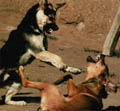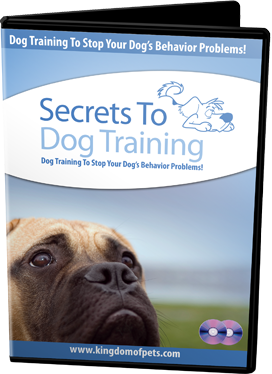In this installment of your 6 Day Course, I'll focus on dog aggression that is expressed toward strangers and other dogs, both of which can be really stressful for dog owners and cause real problems. What you'll find out is that aggressive behavior is just as stressful for your dog, and it's actually your responsibility to teach him or her that the behavior is not only appropriate, but also totally unnecessary. Why is that exactly? I'll tell you. But first let's make sure we know what we're dealing with when we see it.
Most people, whether they are dog owners or not, do not recognize the signs of aggression until it is way too late - until a full-blown dog fight starts or a group of rowdy children are told in no uncertain terms by an annoyed animal that they have crossed the line.
The common signs of aggression are growling, snarling, barking, curled lips, lunging and an overall menacing posture, where the dog is tensed and ready to snap. (Note: there is also something known as a “submissive smile” exhibited by some dogs, whereby the animal actually shows its teeth as it approaches. I’ve seen this behavior confuse many owners, but it can be dismissed as such by the dog’s lowering its head as it “smiles,” and often wag its tail too). There are other indications, such as jumping or mounting or even standing in your way that are much less of a problem and often go ignored when not accompanied by the other more severe signs.
 But all of these are also very obvious and advanced manifestations of aggression. Being able to recognize the behaviors that lead up to these signs will go a long way. For example, dogs unsure about meeting someone new (human or canine) will approach hesitantly and "circle" their opposite. You may likely even see distrust or suspicion in their eyes (with some of the whites showing).
But all of these are also very obvious and advanced manifestations of aggression. Being able to recognize the behaviors that lead up to these signs will go a long way. For example, dogs unsure about meeting someone new (human or canine) will approach hesitantly and "circle" their opposite. You may likely even see distrust or suspicion in their eyes (with some of the whites showing).
Dogs also have two areas on their back, their "hackles," where they are able to raise the hair on their coat. Located between the shoulders and just above the tail, raised hackles will be more obvious on some dogs than others depending on the coat, but it always means a very heightened state of awareness and excitement, and is the prelude to aggression. So, even though raised hackles do not automatically mean aggression, it means you should pay attention and do your part to ensure that there is no reason for the situation to escalate into an aggressive one. What is your part exactly?
In most cases dogs become aggressive because they don't know what else to do. The reason they don't know what else to do is because there is no one else there to tell them or show them what to do, or even assure them that they should do NOTHING instead. In the absence of your guidance and leadership, they are forced to make all these decisions on their own. That's not only a downright dangerous position to put them, it's also unfair.
This is something that professional trainer Brian Heward explains quite well in the Dog Training DVD Series that we have put out at Kingdom of Pets. He talks a lot about establishing your role as leader. Now everyone knows how very important it is to position yourself at the top of the "pack" in your hybrid family of humans and dogs. But Brian really makes sense of why it is in fact *more* stressful for a dog who is a dominant "Alpha" dog but really does not want to be.
When a dog's role is not made clear by his owner, the pressure is on the dog to protect his owner, protect his territory, not to mention protect himself so his own role does not come into question. That's a lot of work and a lot of worry. And the result is all too often an aggressive dog that really does not need to be that way. Punishing a dog who is ultimately trying to watch out for everyone inevitably makes things worse.
To give you some examples, now that you know what aggressive posturing looks like, if you see these signs in another dog, AVOID that dog on your walks. At the same time, keep your confidence and your nerves intact when you do: your dog is sensing every last bit of your anxiety, and perhaps even feeling it (how many times have you seen tense owners pull in their lead for dear life when you walk by with your dog?). Just tell your dog that you'll be taking a wide berth, and walk calmly past. If there's not enough space to do that even, have your dog on a "sit" command and place yourself (the leader of the group) in between yourself and the suspect dog as it walks past. If the owner does not keep their dog under control, you might even let them know about it.
The opposite applies: if you come across a dog that is exhibiting playful and friendly signs, TELL your dog that this is a "friend" and that a greeting is ok. If possible, I've found that it works well if you greet the dog first, then "ok" the mutual canine greeting second.
All in all, you need to communicate to your dog what is a genuine threat and what is not, and in reality, there is not all that much in this world that should be a genuine threat to your dog if you're doing your job as the boss. More than that, you need to communicate in a calm yet assertive manner. It's about body language remember. No matter what you SAY, if you ACT like you're freaked out, your dog will do the same.
As Brian says, our world does not equal a dog's world - our world is much bigger, much noisier, and indeed, much scarier. But it is our world that we've asked our dogs to live in. Not only that, we've asked them to behave in it too. All the more reason they need the right sort of guidance.
A lesson on dog aggression would not be complete without at least a brief discussion about the cornerstone of dog obedience: SOCIALIZATION. Socialization just means letting your dog figure out how to behave in social situations by regularly putting him or her in social situations. This starts right from the puppy days. Your dog needs to interact with other dogs and other people absolutely as much as possible. Dogs that are not socialized with other people and other dogs are very often the same dogs that have aggression problems.
When your puppy has play sessions with other dogs, keep an eye out for dogs that will get along with yours, and make a point of seeing these dogs again. But also let your dog interact with other dogs - older and bigger dogs - who will keep your dog "in line" if he or she happens to be exhibiting dominant behavior. On the other extreme, do not let your dog hang out with other dogs that tend to roughhouse too much or bully yours around to the point where they are causing the dogs stress and stunting confidence. Dog socialization is a hugely important topic, and it's one that Susan Morton, the dog trainer who co-presents the Kingdom of Pets dog training DVDs with Brian, has a lot more to say about in those videos. She'll tell you all about how to choose your dog's friends wisely!
 Remember, the more familiar a situation is to your dog, the more comfortable they will be - "human animals" are exactly the same! - and the less they will need your guidance and instruction. If your dog sees no one aside from you for most of the hours of most days, and sees very little outside the confines of your own backyard, can you blame them for acting a bit strange when they actually get out into the big wide world?
Remember, the more familiar a situation is to your dog, the more comfortable they will be - "human animals" are exactly the same! - and the less they will need your guidance and instruction. If your dog sees no one aside from you for most of the hours of most days, and sees very little outside the confines of your own backyard, can you blame them for acting a bit strange when they actually get out into the big wide world?
Until then,
![]()
Daniel Stevens
Secrets to Dog Training
http://www.kingdomofpets.com/dogobediencetraining/
 I've been a professional dog trainer for well over 20 years, and in that time I've helped thousands of dog owners just like you to get the friendly, well behaved, slipper fetching, best pal they always wanted.
I've been a professional dog trainer for well over 20 years, and in that time I've helped thousands of dog owners just like you to get the friendly, well behaved, slipper fetching, best pal they always wanted.
But it didn't start out that way. I've always loved dogs, some things never change. But when I first started my professional dog training career I relied on the so-called 'best practices' when it came to dog behavior training. It was only when I heard people tell me over and over again that they just weren't seeing results that I started to question the old accepted wisdom. So I started a journey, a quest to search out the best, most effective, techniques, tips, and tricks that really work.
And that's how I came up with Secrets to Dog Training. Year after year I found new techniques that achieved the results I wanted. Eventually I had a whole book worth of great resources: Secrets to Dog training...
So, if you want to:
Then Secrets to Dog Training is just what you've been looking for!
Previous Newsletters